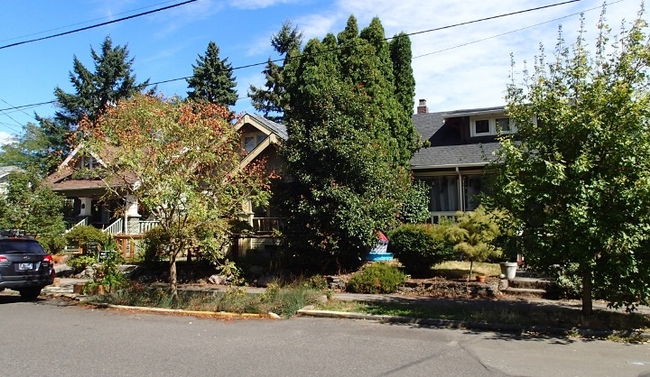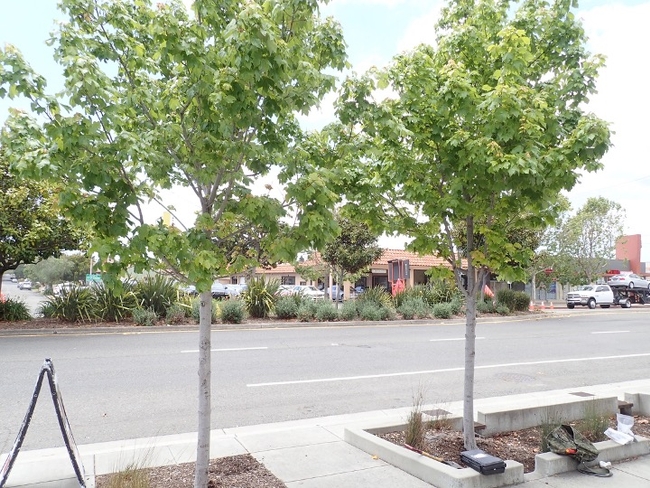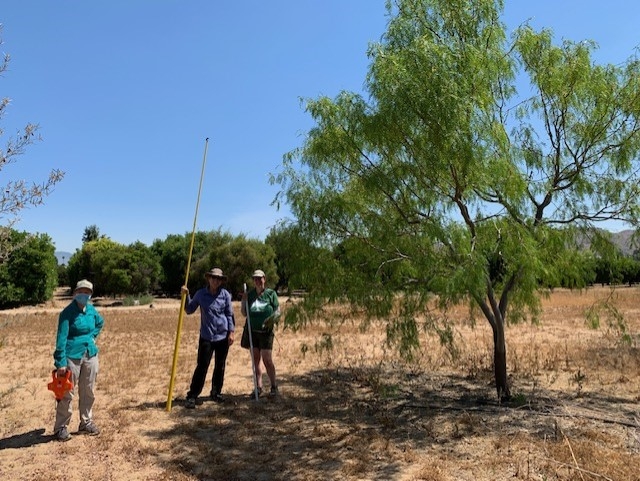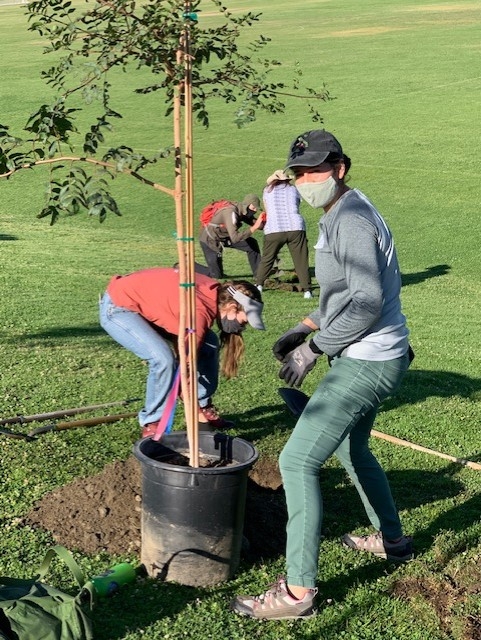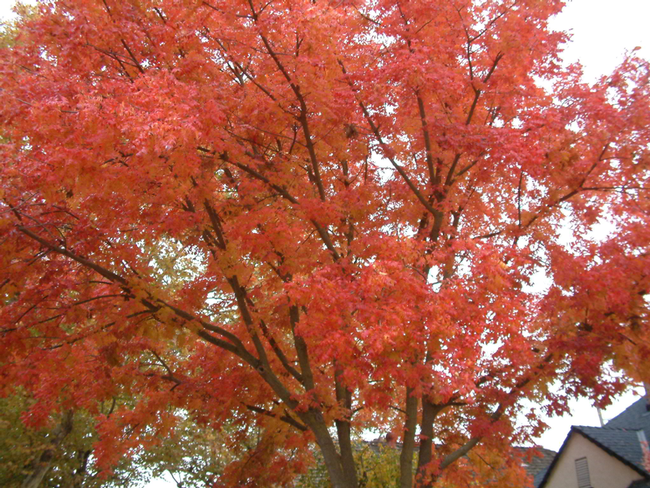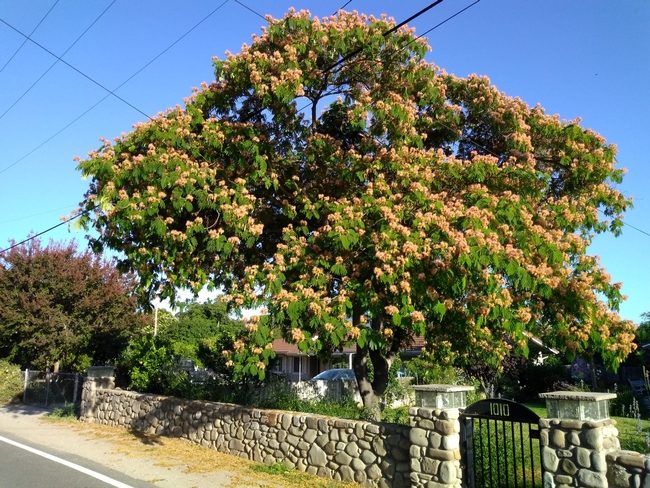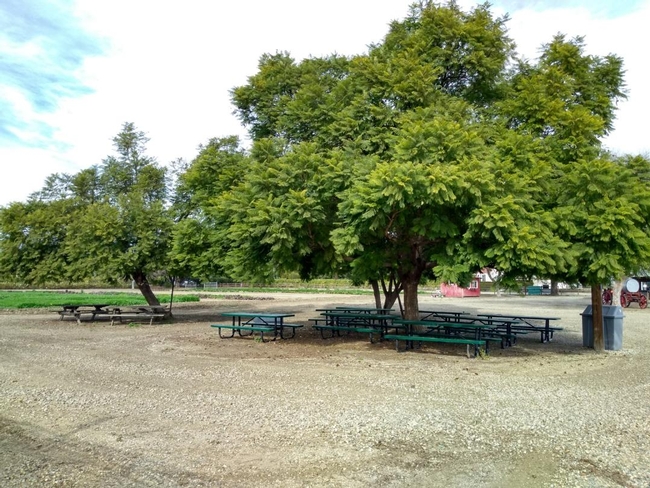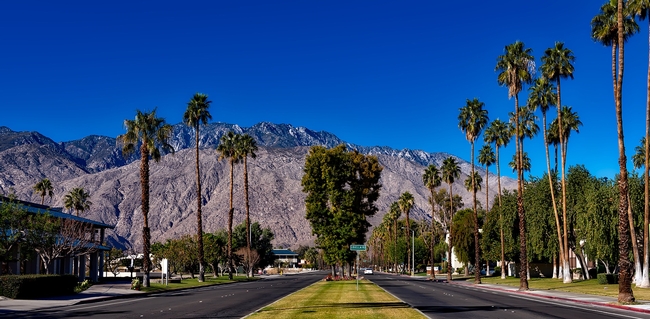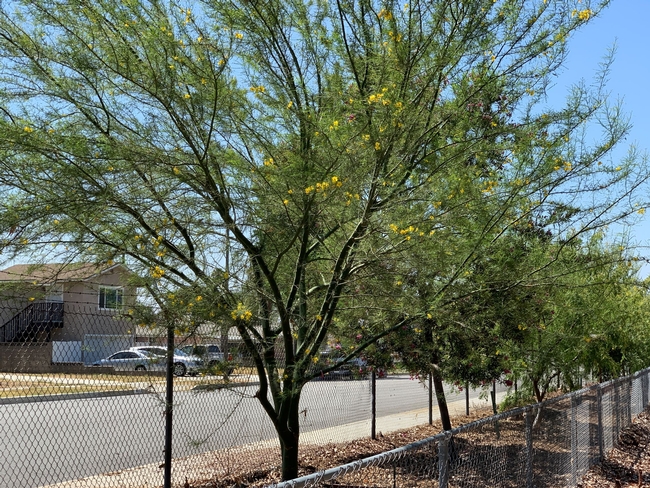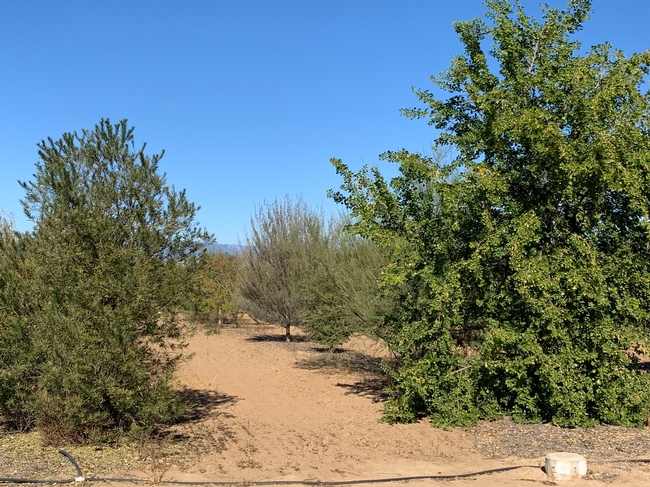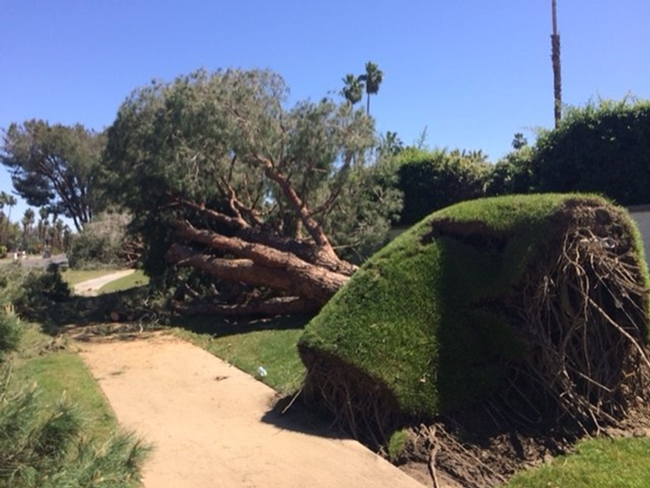Posts Tagged: trees
The science of care for ‘calming and sublime’ trees in urban areas
The green leaves of the trees that line city streets soften the visual harshness of concrete and asphalt. Walking in the shade of their canopy, you may not think about how trees live in a small patch of soil surrounded by sidewalks and streets.
Behind every thriving street tree is science. Scientists evaluate trees to determine which species will grow well in a particular environment. Scientists study the best ways to protect the tree against pests and diseases. Scientists research how to prune the tree for the best performance.
“I think that the most overlooked and under-recognized value of trees is the subtle calming and healing effect that urban trees and natural green spaces have on people, and this effect is amplified once people become aware of it,” said Stephen Prée, environmental programs manager and city arborist for the City of El Cerrito. “While trees are calming and sublime, they are also busy at work removing pollutants from the soil and the air as they expel oxygen and moisture.”
“Our community uses our parks and natural areas as a vehicle for personal and community replenishment and revitalization. In the El Cerrito natural area, we see our community members relaxing in the shady ambience of a grove of trees, we see families or friends connecting with each other, we see volunteers working together to sustain native plant habitat,” said Prée, who is partnering with Igor Lacan, UC Cooperative Extension horticulture advisor for the Bay Area, on a study of streetside stormwater basins, or bioswales.
University of California Cooperative Extension horticulture advisors and specialists work with arborists, park superintendents, landscapers and many other professionals to support urban trees.
Trees can grow well in bioswales
Bioswales are built to contain stormwater that drains from homes and roads. When landscaped with trees, this green infrastructure provides several “ecosystem services,” says Lacan, such as filtering dust from the air, creating windbreaks, capturing stormwater runoff, muffling street noise, and providing habitat for birds and other wildlife. Some arborists are reluctant to plant trees in bioswales, concerned that the trees will fail if they don't have enough space to grow or get too much water in the winter and not enough water in the summer.
New research by Lacan shows trees can grow as well in bioswales as in other landscapes. To evaluate the performance of street trees, he monitored 23 tree species in 93 bioswales across five cities in the San Francisco Bay Area and in Portland, Ore., over five years.
Lacan's study showed that in the Bay Area trees grow well if they are irrigated in the summer, otherwise insufficient soil moisture may limit their growth. Importantly, he also found no evidence of waterlogging in the winter, thanks to quick drainage in the sandy soil. Although bioswale substrates tend to be composed of more sand than silt and clay, Lacan found the bioswale soils contain a comparable amount of plant nutrients to some other urban soils.
“Salinity isn't a problem unless de-icing salts are used,” said Lacan, who is part of the University of California Agriculture and Natural Resources or UC ANR. “It may become a problem where recycled water is used for irrigation, but routine soil tests are probably not needed unless the trees show symptoms of salinity or nutrient deficiency.”
A grant from UC ANR's California Institute for Water Resources enabled Lacan to start the bioswale study, and his successful research garnered additional funding from the U.S. Forest Service to continue the five-year study.
UC Master Gardeners take on BEaST
To share what he's learned, Lacan has enlisted UC Master Gardener volunteers in what he calls the Bioswale Education and Stewardship Training, or BEaST, project in Half Moon Bay. The UC Master Gardener Program is also part of UC ANR.
He is training UC Master Gardener volunteers to document trash and debris accumulation, and assess plant condition and soil texture, compaction, moisture and infiltration rate in bioswales. They report their observations via the smartphone app Survey 123 and a survey created by Lacan.
“That's the power of UC ANR,” Lacan said. “Thanks to the software license that UC ANR holds, we are able to use smartphones to collect data. It makes for a streamlined, comprehensive way to handle data and share the results with our San Mateo County partners who are supporting this project.”
The UC Master Gardener volunteers will in turn teach youth members of 4-H, another UC ANR program, and community members how to care for the plants in bioswales.
Monterey oak survey study
In Monterey County, Lacan is working with Justin Prouty, urban forester for the City of Monterey, on the Monterey Oak Survey Study. For the project, community members collect data on the condition of local oak trees.
“The most valuable aspect of this particular project is community awareness and engagement in their urban forest,” Prouty said. “I believe that having community members out simply observing trees and maybe noticing some of them for the first time is valuable in itself. My hope is the more people become involved in the care and advocacy for their urban forest, the more interest and funding will be directed towards its care.”
This project has helped Prouty and others in his department meet community members who would like to volunteer and advocate for maintaining the urban forest, he said.
“Another important piece is the access to UC Cooperative Extension staff who have insight into forest health and management in similar communities throughout the state,” Prouty said. “Over the past year or so that Igor and I have been working together, I have made connections with several people who have helped influence our strategy towards our own forest management.”
Projects such as these require partners who contribute different skills for the benefit of everyone involved, Lacan said. He explained that the County of San Mateo wanted to partner with him to inform its residents how to care for local stormwater infrastructure.
“For the BEaST project, we need a municipal agency partner in each city where the bioswales are located, then a funding source such as the San Mateo County Stormwater Program, and finally an outreach partner, which is our UC Master Gardeners,” Lacan said. “Without the comprehensive nature of UC ANR, none of this would happen.”
People should care about urban trees, said Prée, “Because the trees are improving the environment for all living things.”
The importance of trees to cool urban heat islands
Partnering for California
Spring 2021 proved to be one of the hottest in California, breaking heat records in several cities. It was a perfect opportunity to plant “climate-ready landscape trees” in inland cities identified in a study conducted by the University of California Cooperative Extension in partnership with the U.S. Forest Service.
The idea of bringing together community groups and volunteers to enhance tree canopies that cool urban heat islands --which can be more than 50 degrees hotter than surrounding areas -- in the Redlands area was spawned by Janet Hartin, UC Cooperative Extension environmental horticulture advisor for Riverside, San Bernardino and Los Angeles counties.
It became a reality when Mandy Parkes, district manager of Inland Empire Resource Conservation District, and Shelli Stockton of the University of Redlands received partner grants from the Climate Action Corps to start a nursery and get the “climate-ready landscape trees” in the ground. To date, nearly 100 trees from the study have been planted, including over 40 at the Redlands Sports Complex. As the volunteers in Redlands know, planting trees helps to cool these heat islands. After a long day of digging and planting in June, the volunteers were satisfied with their hard work and looked forward to sharing their experiences.
According to Parkes: “The project is moving along quickly due to excellent work of the Climate Action Fellows; inspiring research and support from Janet Hartin and the UC Cooperative Extension Master Gardeners who will ensure that residents continue to receive proper tree care help long after the planting ends; outreach by Mario Saucedo and his Redlands-based community action nonprofit organization, Common Vision Coalition.”
Saucedo, chairman of Common Vision Coalition, said, "It came together, all of us round-tabling on how we could do this pilot project and reach out to the community residents and offer them free trees for their homes."
Once the community accepted the project, the outreach began. James Berry of the California Climate Action Corps was excited after they got the green light from the city of Redlands to plant the trees.
"They are from two different species," said Berry. "The Western Bud and the Red Push Pistache. Both are heat tolerant and drought tolerant, making them ideal for the high temperatures we are facing, and the ones in the coming years as a result of the climate change."
“Our ‘Trees for Tomorrow' workshop we held last fall for city planners, wholesale and retail nursery personnel, landscape architects, landscapers, water districts community groups, and Master Gardeners resulted in pockets of multidisciplinary projects, tree planting projects across Southern California, including the Redlands project. The Redlands project exemplifies the core principles of a well thought out and executed project that includes long-term tree care, a real key to maximizing benefits of trees over their lifespans of 50 years and more.”
With a statewide drought forcing water restrictions, people are looking into options to save water. Hartin advises against sacrificing any trees.
"One of the things that I think is important to prioritize is to make sure that when we have to reduce our water use outside in urban areas, we maintain our trees as a top priority," said Hartin. "If that means for a year or two that our lawns and our flowering beds are going to go by the wayside, then that's just the situation."
She recommends something as simple as dragging a hose out and into the tree's drip line, making sure not to water the trunk, but the other side of the drip line where the active root system is.
"Climate-ready tree study: update for Southern California communities" by E. Gregory McPherson, Alison Berry, Natalie van Doorn, Janet Hartin, Jim Downer, Darren Haver and Erica Teach is published at https://www.fs.usda.gov/treesearch/pubs/60414.
To learn more about the study or how to combat climate change with trees:
“Trees for tomorrow start today.”
“Lush urban forest can help communities face climate change.”
Tree lovers invited to free webinars to learn proper tree-care
While spring may not be the best time to plant shade trees, many people are inspired to plant trees as part of Earth Day and Arbor Day celebrations. Millions of trees are planted every year in America and many of them perish after planting, according to James Downer, University of California Cooperative Extension horticulture and plant pathology advisor.
“Tree planting campaigns, while well intentioned, may not consider all the realities of bringing young trees into landscapes and caring for them over decades,” Downer said. “Increasingly, city budgets for tree care are being cut back and planting budgets are non-existent in many cities. Tree planting is left to volunteer groups, homeowners, schools and other organizations that may want trees in their communities.”
Planting is just the first step in trees' lives and can also be the reason for their demise if they are not planted correctly. Trees that survive initially may perish later in their young lives due to poor maintenance or exotic pests or from drought.
To teach members of the public how to select and care for trees, Downer will host a series of free webinars. The five one-hour sessions will cover tree selection, where and how to plant a tree, how to prune trees, how to feed and water them, and pest management. Downer, who is based in Ventura County, welcomes all tree enthusiasts.
When: Thursdays beginning April 22, 2021
Time: 12:30 – 1:30 p.m.
Registration and details at https://ucanr.edu/survey/survey.cfm?surveynumber=33331.
Schedule:
April 22: Selection of Trees (benefits of trees)
April 29: Planting Trees
May 6: Pruning Trees
May 13: Caring for Trees (mulch, water, fertilizer)
May 20: Managing tree pests and diseases
“Establishing trees starts with tree selection—planting the right tree in the right place,” Downer said. “As trees grow and begin to fill their space in gardens, landscapes, parks or city streets they begin to require other kinds of care.”
Downer, who holds a Ph.D. in plant pathology from UC Riverside, has 35 years of experience in horticulture and plant pathology. His research focuses on diseases of shade trees and other landscape plants and cultural practices to maintain landscape plants, especially trees. He also studies the use of mulch, soil microbiology and disease suppression in mulched soils.
No need to amend soil when planting new trees or perennials
Gardeners who follow conventional wisdom and nursery recommendations to mix organic amendments into the soil when planting new trees or perennials in their landscapes are making a mistake, according to UC Cooperative Extension environmental horticulture experts.
“This is one of the garden myths that I'm trying to dispel,” said Jim Downer, UCCE environmental horticulture advisor in Ventura County. “We recommend residents not amend the soil when they are planting based on outcomes we have observed in research.”
Downer and Ben Faber, UCCE advisor for water, soils and subtropical crops in Ventura County, summarized this and other information about the use of organic amendments in home landscapes in a six-page publication now available for free download from the UC Agriculture and Natural Resources catalog at https://anrcatalog.ucanr.edu/Details.aspx?itemNo=8711.
The publication says research has not shown that adding amendments to planting holes for perennial plants provides a significant advantage compared to using native backfill.
With perennial plants, the roots do not stay in the planting hole for long, so amendments would only be effective for a short time. The practice of amending the soil further harms the plant by creating an interface where the soil in the planting hole is different from the native soil.
“When that happens, roots and water don't move as well through the soil,” he said.
While there are few reasons to mix organic amendments into the soil, Downer said mulching the soil surface with uncomposted organic matter is almost always beneficial.
“If your goal is to get organic matter into the soil, we recommended topping the soil with fresh, undecomposed wood chips. It will give you microbial stimulation and suppress disease. Arthropods will slowly grab pieces of the mulch and incorporate it into the soil at a gentle rate,” he said.
The publication also provides information about various common organic amendments – such as coconut fiber, coffee grounds, horse manure, peat moss and green waste compost – with details about each product's benefits and detriments.
Lush urban forests can help communities face climate change
Urban trees are much more than lovely greenery and stately landscape features. Scientists believe trees are a key tool for combating climate change and living with warming temperatures in California.
UC Cooperative Extension is bringing together municipal and nonprofit organizations, homeowners associations, contractors, the green industry and educators to increase the tree canopy in urban areas by planting recommended species. Nearly 200 people gathered online in March 2021 to share research results, accomplishments and tree canopy growth strategies at the “Trees for Tomorrow Start Today” workshop.
“We need to act now and together to build community forests,” said Janet Hartin, UCCE area environmental horticulture advisor in Southern California and the event organizer. “This is the time to talk about challenges and opportunities for a healthier tomorrow. As our cities grow, so do associated urban heat islands like asphalt-covered parking lots and streets.”
For decades, temperatures have been rising across the planet. While governments work worldwide to reduce carbon dioxide and other emissions that contribute to the greenhouse gases warming the earth, trees are a particularly effective way to make a significant impact on the problem at the local level.
“With proper placement around homes, trees can reduce home energy cost by 30 to 50 percent,” Hartin said. “Treeless urban parking lots can be 20 to 25 degrees hotter than park-like settings in the same area.”
Trees have myriad additional benefits. They provide cooling shade to sidewalks, schools and shopping centers. Trees remove dust from the air, create windbreaks, capture runoff, reduce glare, muffle urban noise and provide a habitat for birds and other animals. In the process of photosynthesis, trees also absorb and store carbon dioxide, helping reduce greenhouse gas emissions to the atmosphere.
With so many reasons to plant and maintain trees in urban communities, and with the overarching threat of climate change, there's no time to waste in nurturing lush green canopies in California cities, schools, parks and neighborhoods. Hartin said ensuring the proper tree selection, placement and care is critical.
“Trees improperly selected or not properly cared for are taking precious time away from the future benefit of trees,” she said.
UC conducts long-term research to identify the best urban trees
Hartin is working with a team of UC Agriculture and Natural Resources and U.S. Forest Service scientists to identify the best drought- and heat-tolerant trees for different areas of the state. Six years ago, the team vetted 100 trees native to California, the Southwest and Australia, taking into account habitat, physiology and biological interactions. A selection of fast-growing, drought-, heat- and pest-resistant species were planted at UC Riverside, the UC South Coast Research and Extension Center in Irvine and in Northern California to be evaluated over 20 years. In addition, Hartin has a subset of trees in a ‘mulch, no mulch' study at Chino Basin Water District in Montclair.
“We're beginning to see the best performers in those areas,” said Hartin, who shared a few of the tree species that have already caught her fancy.
Island Oak (Quercus tomentella) – A disease-resistant evergreen California native adapted to many Sunset magazine zones and soils.
Netleaf Hackberry (Celtis laevigata var. reticulate) – A deciduous tree with small red berries that attract birds. “This is performing beyond our expectations,” she said.
Thornless Honey Mesquite – (Prosopis glandulosa ‘Maverick') – Native to the Southwest U.S., the tree is heat tolerant and cold hardy. It grows as wide as it is tall – about 35 feet.
Pistacia ‘Red Push' (Hybrid of Pistacia atlantica × Pistacia integerrima) – Developed in Arizona, the tree grows 20-feet tall. “The foliage makes you think of Maine or Minnesota in the fall, but this tree has a brilliant red tinge when it first leafs out in the spring,” she said. “It's performing really well in our studies.”
Bubba Desert Willow (Chilopsis lineraris ‘Bubba') – “My favorite tree from our study,” Hartin said. “It grows fast, has beautiful trumpet-like flowers and requires little maintenance.”
Hartin recommends finding more details about these and other trees at http://selectree.calpoly.edu. Read more about the project here: UC study seeks street trees that can cope with climate change.
UC Master Gardeners provide advice on tree selection and maintenance
Proper location based on climate zone and specific conditions around one's home, planting and maintenance are important for tree longevity. Helpful information and support is available throughout California from UC Master Gardener Program volunteers.
Mandy Parkes of the Inland Empire Resource Conservation District said Master Gardeners are a “pivot point” for successful tree planting. She spearheaded a tree planting program in North Redlands that involves partnerships with the California Climate Action Corps, the city, ESRI, University of Redlands and UCCE to encourage residents to plant trees where the urban canopy is currently low.
“New tree owners need long-term support to aid selection and placement of trees,” Parkes said. “Master Gardeners can weigh in on yard design, irrigation and most importantly, guiding trees into the ground and caring for them correctly and in a way that works for the residents.”
Studies have shown that there is often less tree canopy cover in lower-income communities. In many under-served neighborhoods, canopy cover ranges from 0 to 11%, Hartin said, far short of the recommended 25% canopy cover.
“In wealthier neighborhoods, there tends to be higher canopy cover, and in addition, in those areas there is less asthma and cardiovascular disease,” Hartin said. “Encouraging planting in low-income neighborhoods is one of our goals.”
Andy Lyons, program coordinator for UC ANR's Informatics and GIS Statewide Program and a workshop participant said, “GIS technology and data offer exciting new possibilities for managing our urban trees, including the ability to create highly accurate maps of urban trees from aerial imagery, mobile data collection apps to monitor tree health, and the ability to overlay climate change projections for species selection and planning."
Threats to urban trees
Threats to trees were also discussed at the day-long Trees for Tomorrow meeting. West Coast Arborists' Cris Falco said he is frequently dismayed to see poorly pruned trees. “In my opinion, poor tree work is still the rule, not the exception,” he said.
A common mistake is cutting back, or heading, branches, while the goal should be a natural system of pruning to retain and promote characteristic growth. But, with 90% of the urban forest grown on private property, all too often poor tree architecture or inferior branch structure can lead to early tree failure. Falco and other speakers recommended regular pruning by a certified arborist.
Insect pests and diseases can also get in the way of long-term tree survival. Dave Rogers is a recently retired city arborist and currently acting director of the Community Services Department in Claremont, a college town in eastern Los Angeles County known as the “City of Trees and Ph.D.s.” He said the polyphagous shot hole borer reached Claremont and threated to kill heritage oaks and sycamores. Rogers gathered information and shared it with the city council, who provided $300,000 to treat infested trees. “The treatments worked,” he said.
But the pest continues to threaten trees in Los Angeles and Orange counties. One of the promising trees in the Trees for Tomorrow climate study, the Thornless Desert Museum Palo Verde, was found to be susceptible to shot hole borer, so experts are not recommending residents plant this tree.
Another pest, the ash borer, is in Eastern Texas and Boise Idaho, and will likely make its way to the West Coast eventually, said plantsman and workshop participant Nicholas Staddon of Everde Growers.
“It will kill every single ash tree we have,” said Staddon, who was a plant specialist at Monrovia Wholesale Nursery for many years. “We have to look at a broader diversity of trees. From the growers' perspective, trees are the most expensive items we grow. People who want to buy trees need to have some financial skin in the game for growing them.”
Making trees that are climate-tolerant but less common available to the public at nurseries is another hurdle. Nurseries carry what people are asking for, but people don't always know about tested species and even older, “tried and true” varieties.
“We have a list of trees adapted to the climate that are water wise, but at this point, it is difficult to find those in the nurseries,” said Debby Figoni, UC Master Gardener and water administrator for City of Beverly Hills. “It's one thing to know what you're supposed to plant. It's another to find that tree. We have to give people resources.”
The rich discussion regarding the need to enhance tree canopies with recommended species and proper long-term care did not end at the conclusion of the workshop, Hartin said.
“A goal of the workshop was to identify ways to work together more effectively across professions,” she said. “Lots of great ideas came out of the roundtable discussions that we'll be following up on. These include providing education on proper tree selection and care through local task forces consisting of members of the nursery and landscape industry and regular communication between these groups.”


